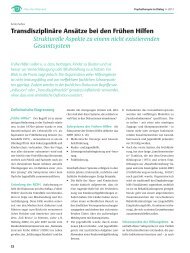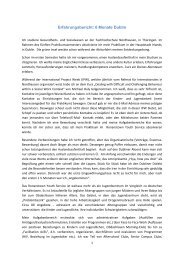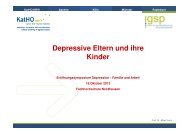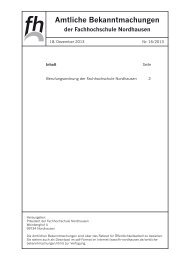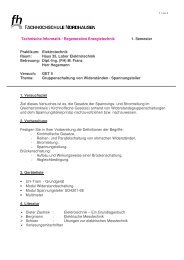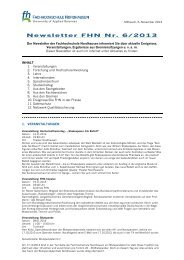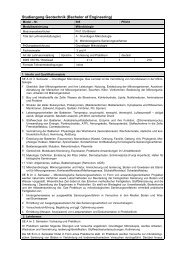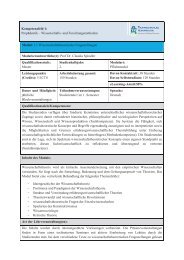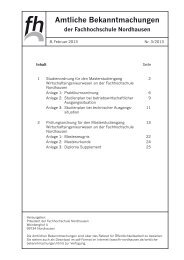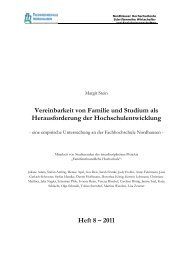application of the kano model to sensory ...
application of the kano model to sensory ...
application of the kano model to sensory ...
You also want an ePaper? Increase the reach of your titles
YUMPU automatically turns print PDFs into web optimized ePapers that Google loves.
Cus<strong>to</strong>mer<br />
satisfied<br />
Cus<strong>to</strong>mer<br />
neutral<br />
Cus<strong>to</strong>mer<br />
dissatisfied<br />
Needs not fulfilled<br />
Attractive<br />
Attribute<br />
Needs fulfilled<br />
Performance<br />
Attribute<br />
Must-be<br />
Attribute<br />
Application <strong>of</strong> <strong>the</strong> Kano <strong>model</strong> <strong>to</strong> Sensory<br />
Science - a new approach <strong>to</strong> develop <strong>the</strong><br />
“ideal” fruit smoothie<br />
Presentation at <strong>the</strong> 8th Pangborn Symposium<br />
July, 29 th 2009<br />
8 th Pangborn Symposium Florence
Content<br />
Background / Research questions<br />
1. Illustration <strong>of</strong> <strong>the</strong> product evaluation by consumers<br />
2. Illustration <strong>of</strong> <strong>the</strong> product perception by <strong>the</strong> descriptive panel<br />
3. Data linkage, classification in<strong>to</strong> Kano’s typology<br />
Management Summary<br />
8 th Pangborn Symposium Florence<br />
page 2
Background / Research questions<br />
Kano´s Model uses three categories <strong>of</strong> attributes: “Attractive Attributes”,<br />
“Performance Attributes” and “Must-be Attributes”.<br />
All three attributes are following <strong>the</strong><br />
rules:<br />
The more intense <strong>the</strong> more satisfying<br />
Or<br />
The less intense <strong>the</strong> more satisfying<br />
Needs not<br />
fulfilled<br />
Two possible<br />
preferred<br />
directions <strong>of</strong><br />
Intensity<br />
Cus<strong>to</strong>mer<br />
satisfied<br />
Cus<strong>to</strong>mer<br />
neutral<br />
Cus<strong>to</strong>mer<br />
dissatisfied<br />
8 th Pangborn Symposium Florence<br />
Attractive<br />
Attribute<br />
Must-be<br />
Attribute<br />
Performance<br />
Attribute<br />
Needs<br />
fulfilled<br />
+ -<br />
page 3
Background / Research questions<br />
Two Reasons for modifying <strong>the</strong> <strong>application</strong> <strong>of</strong> Kano´s Model<br />
1. Consumers are not able <strong>to</strong> split <strong>the</strong> complex <strong>sensory</strong> perception food and<br />
beverage products in<strong>to</strong> single product attributes in terms <strong>of</strong> answering <strong>the</strong><br />
functional and dysfunctional question for every attribute<br />
2. Untrained consumers cannot measure intensities for single attributes<br />
=> Solution <strong>to</strong> solve <strong>the</strong>se problems:<br />
1<br />
2<br />
3<br />
Consumer Test in order <strong>to</strong> measure <strong>the</strong> level <strong>of</strong> satisfaction for<br />
each sample <strong>of</strong> <strong>the</strong> yellow smoothies.<br />
Descriptive Analysis with <strong>the</strong> same sample in order <strong>to</strong> gain<br />
objective perception measures.<br />
Linkage <strong>of</strong> consumer data and perception; adaptation <strong>of</strong> <strong>the</strong><br />
Kano Model <strong>to</strong> identify <strong>the</strong> three attribute categories<br />
8 th Pangborn Symposium Florence<br />
page 4
1<br />
2<br />
3<br />
Background / Research questions<br />
Structure <strong>of</strong> <strong>the</strong> research project<br />
Consumer Test in order <strong>to</strong> measure <strong>the</strong> level <strong>of</strong><br />
satisfaction for each sample <strong>of</strong> <strong>the</strong> yellow<br />
smoothies.<br />
Descriptive Analysis with <strong>the</strong> same sample in<br />
order <strong>to</strong> gain objective perception measures.<br />
Linkage <strong>of</strong> consumer data and perception via PLS1<br />
- adaptation <strong>of</strong> <strong>the</strong> Kano Model <strong>to</strong> identify <strong>the</strong> three<br />
attribute categories<br />
Three sessions<br />
with 120<br />
consumers<br />
<strong>sensory</strong><br />
pr<strong>of</strong>iles <strong>of</strong> <strong>the</strong><br />
16 smoothies<br />
1. Linkage <strong>of</strong> <strong>the</strong> 16<br />
<strong>sensory</strong> pr<strong>of</strong>iles <strong>to</strong> <strong>the</strong><br />
5 satisfying & 5<br />
dissatisfying products<br />
(for each consumer)<br />
2. Clustering <strong>the</strong><br />
consumers in three<br />
clusters depending on<br />
both linkages<br />
3. Identifying <strong>the</strong> 3 Kano<br />
attribute categories for<br />
each cluster<br />
8 th Pangborn Symposium Florence<br />
1. Setting a satisfaction threshold for<br />
each consumer for <strong>the</strong> 16 smoothies<br />
2. Acceptance <strong>of</strong> 5 satisfying products<br />
3. Acceptance <strong>of</strong> 5 dissatisfying<br />
products<br />
Cus<strong>to</strong>mer<br />
satisfied<br />
Cus<strong>to</strong>mer<br />
neutral<br />
Cus<strong>to</strong>mer<br />
dissatisfied<br />
<strong>sensory</strong><br />
pr<strong>of</strong>iles <strong>of</strong> <strong>the</strong><br />
16 smoothies<br />
<strong>sensory</strong><br />
pr<strong>of</strong>iles <strong>of</strong> <strong>the</strong><br />
16 smoothies<br />
…Acceptance<br />
<strong>of</strong> 5 satisfying<br />
products<br />
…Acceptance<br />
<strong>of</strong> 5<br />
dissatisfying<br />
products<br />
Cluster 1 Cluster 2 Cluster 3<br />
Needs not fulfilled<br />
Attractive<br />
Attribute<br />
Needs not fulfilled<br />
Performance<br />
Attribute<br />
Must-be<br />
Attribute<br />
Cus<strong>to</strong>mer<br />
satisfied<br />
Cus<strong>to</strong>mer<br />
neutral<br />
Cus<strong>to</strong>mer<br />
dissatisfied<br />
Needs not fulfilled<br />
Attractive<br />
Attribute<br />
Needs not fulfilled<br />
Performance<br />
Attribute<br />
Must-be<br />
Attribute<br />
Cus<strong>to</strong>mer<br />
satisfied<br />
Cus<strong>to</strong>mer<br />
neutral<br />
Cus<strong>to</strong>mer<br />
dissatisfied<br />
Needs not fulfilled<br />
Attractive<br />
Attribute<br />
Needs not fulfilled<br />
Performance<br />
Attribute<br />
Must-be<br />
Attribute<br />
page 5
With apple &<br />
mango<br />
bits (Market<br />
standard)<br />
With lots <strong>of</strong><br />
apple &<br />
mango bits<br />
Background / Research questions<br />
16 samples were provided for this research, all modifications <strong>of</strong> an existing<br />
market product.<br />
Only<br />
mango<br />
bits<br />
Only<br />
apple<br />
bits<br />
Dominant<br />
banana<br />
impression<br />
Dominant<br />
passion fruit<br />
impression<br />
Brown<br />
colour<br />
Standard without bits<br />
Orange<br />
Colour<br />
Coconut<br />
taste<br />
Vanilla<br />
Taste<br />
8 th Pangborn Symposium Florence<br />
Reduced<br />
viscosity<br />
Increased<br />
Viscosity<br />
Sweet<br />
alternative<br />
Sour<br />
Alternative<br />
Sweetness<br />
& sourness<br />
reduced<br />
page 6
1<br />
Illustration <strong>of</strong> <strong>the</strong> product evaluation by consumers<br />
Setting a satisfaction threshold based on <strong>the</strong> <strong>model</strong> <strong>of</strong> limited purchase<br />
decisions (Foscht/ Swoboda, 2004, S. 154)<br />
I will certainly not consume this product again<br />
I will probably not consume this product again<br />
I will probably consume this product again<br />
I will certainly consume this product again<br />
Evoked Set<br />
☺<br />
Total Set<br />
Awareness Set Unawareness Set<br />
Inert Set<br />
<br />
8 th Pangborn Symposium Florence<br />
Dissatisfying products<br />
Satisfying products<br />
Inept Set<br />
<br />
page 7
1<br />
Illustration <strong>of</strong> <strong>the</strong> product evaluation by consumers<br />
1. Session: Each consumer tried all 16 smoothies and decided<br />
individually if he/she would consume <strong>the</strong>m again or not.<br />
Step 1: Unforced decision<br />
Step 2: Forced decision<br />
8 th Pangborn Symposium Florence<br />
page 8
1<br />
Illustration <strong>of</strong> <strong>the</strong> product evaluation by consumers<br />
8 th Pangborn Symposium Florence<br />
page 9
1<br />
Illustration <strong>of</strong> <strong>the</strong> product evaluation by consumers<br />
2. and 3. Session <strong>of</strong> <strong>the</strong> Consumer Test: Each consumer rated 5 out <strong>of</strong> his<br />
satisfying and 5 out <strong>of</strong> his dissatisfying smoothies on a 9-point hedonic scale<br />
Cus<strong>to</strong>mer<br />
satisfied<br />
Cus<strong>to</strong>mer<br />
neutral<br />
Cus<strong>to</strong>mer<br />
dissatisfied<br />
Needs not fulfilled<br />
Attractive<br />
Attribute<br />
Needs fulfilled<br />
Performance<br />
Attribute<br />
Must-be<br />
Attribute<br />
8 th Pangborn Symposium Florence<br />
2. Session<br />
5 out <strong>of</strong> <strong>the</strong> satisfying<br />
smoothies<br />
3. Session<br />
5 out <strong>of</strong> <strong>the</strong> dissatisfying<br />
smoothies<br />
page 10
2. Illustration <strong>of</strong> <strong>the</strong> product perception by<br />
<strong>the</strong> descriptive panel<br />
Approach<br />
8 th Pangborn Symposium Florence<br />
page 11
2<br />
Illustration <strong>of</strong> product perception by <strong>the</strong> descriptive panel<br />
The smoothie samples have been evaluated by <strong>the</strong> Descriptive Panel<br />
Assessment <strong>of</strong> objective perception data:<br />
• The Descriptive Panel (10 panelists // two measurements; n=20) assessed all 16 smoothies that<br />
have been evaluated by <strong>the</strong> consumers.<br />
• All samples have been served with a temperature <strong>of</strong> 7 <strong>to</strong> 8°C.<br />
• For <strong>the</strong> assessment <strong>of</strong> <strong>the</strong> samples <strong>the</strong> panel uses 44 “descrip<strong>to</strong>rs” <strong>to</strong> describe all <strong>sensory</strong><br />
dimensions (appearance, odor, taste, texture, mouth feeling).<br />
• For 31 out <strong>of</strong> <strong>the</strong> 44 descrip<strong>to</strong>rs significant differences can be detectet (p-value is ≤ 0.05)<br />
8 th Pangborn Symposium Florence<br />
page 12
3. Data linkage, classification in<strong>to</strong> Kano’s<br />
typology<br />
Segment-specific classification<br />
8 th Pangborn Symposium Florence<br />
page 13
3 Data linkage, classification in<strong>to</strong> Kano’s typology<br />
101<br />
Consumers<br />
x<br />
For each consumer <strong>the</strong> influence coefficient on acceptance is estimated by using<br />
satisfying & dissatisfying acceptance scores and perception data for PLS 1<br />
<strong>sensory</strong> pr<strong>of</strong>iles<br />
<strong>of</strong> <strong>the</strong> 16<br />
smoothies<br />
Consumer<br />
1<br />
2<br />
3<br />
…<br />
…Acceptance <strong>of</strong><br />
5 individually<br />
satisfying<br />
products<br />
31 statistically significant<br />
Descrip<strong>to</strong>rs<br />
yellow<br />
orange<br />
colour<br />
grey<br />
brown<br />
<strong>to</strong>ne<br />
…<br />
8 th Pangborn Symposium Florence<br />
<strong>sensory</strong> pr<strong>of</strong>iles<br />
<strong>of</strong> <strong>the</strong> 16<br />
smoothies<br />
Consumer<br />
1<br />
2<br />
3<br />
…<br />
yellow<br />
orange<br />
colour<br />
Acceptance <strong>of</strong> 5<br />
individually<br />
dissatisfying<br />
products<br />
31 statistically significant<br />
Descrip<strong>to</strong>rs<br />
grey<br />
brown<br />
<strong>to</strong>ne<br />
…<br />
page 14
3 Data linkage, classification in<strong>to</strong> Kano’s typology<br />
In terms <strong>of</strong> consumers heterogeneity 3 segments have been detected by<br />
an innovative segmentation approach using Wards-Hierarchical-Clustering<br />
Consumer<br />
1<br />
2<br />
3<br />
…<br />
yellow<br />
orange<br />
colour<br />
Segment 1<br />
Containing 40 consumers<br />
31 statistically significant<br />
descrip<strong>to</strong>rs <strong>of</strong> satisfying products<br />
grey<br />
brown<br />
<strong>to</strong>ne<br />
…<br />
Consumer<br />
1<br />
2<br />
3<br />
…<br />
8 th Pangborn Symposium Florence<br />
31 statistically significant<br />
Descrip<strong>to</strong>rs <strong>of</strong> dissatisfying products<br />
yellow<br />
orange<br />
colour<br />
Analysing Segments <strong>of</strong> Consumers by comparing <strong>the</strong> 62<br />
acceptance influencing coefficients <strong>of</strong> every consumer<br />
Segment 2<br />
Containing 40 consumers<br />
grey<br />
brown<br />
<strong>to</strong>ne<br />
…<br />
Segment 3<br />
Containing 21 consumers<br />
page 15
3 Data linkage, classification in<strong>to</strong> Kano’s typology<br />
In <strong>the</strong> following, all “influential” descrip<strong>to</strong>rs were classified <strong>to</strong> <strong>the</strong> three Kano<br />
categories according <strong>to</strong> <strong>the</strong> following classification rules Riviére et al., 2006, S. 576)<br />
• Descrip<strong>to</strong>rs found “influential” only in <strong>the</strong> 3rd<br />
session <strong>model</strong>ling (dissatisfying products)<br />
are must-be attributes<br />
• Descrip<strong>to</strong>rs found influential only in <strong>the</strong> 2nd<br />
session <strong>model</strong>ling (satisfying products) are<br />
attractive attributes<br />
• Key drivers for both sessions <strong>model</strong>ling are<br />
performance attributes.<br />
Cus<strong>to</strong>mer<br />
satisfied<br />
Cus<strong>to</strong>mer<br />
neutral<br />
Cus<strong>to</strong>mer<br />
dissatisfied<br />
8 th Pangborn Symposium Florence<br />
Needs not fulfilled<br />
Session 3<br />
(dissatisfying<br />
products)<br />
Session 2 (satisfying<br />
products)<br />
Attractive<br />
Attribute<br />
Needs fulfilled<br />
Performance<br />
Attribute<br />
Must-be<br />
Attribute<br />
page 16
3 Data linkage, classification in<strong>to</strong> Kano’s typology<br />
Consequences for optimizing <strong>the</strong> ideal smoothie<br />
1. Optimize all must-be attributes <strong>to</strong><br />
avoid dissatisfaction<br />
2. Optimize all performance attributes <strong>to</strong><br />
ensure satisfaction<br />
3. Optimize all attractive attributes <strong>to</strong><br />
arouse high satisfaction level and <strong>to</strong><br />
distinguish from competitive products<br />
Cus<strong>to</strong>mer<br />
satisfied<br />
Cus<strong>to</strong>mer<br />
neutral<br />
Cus<strong>to</strong>mer<br />
dissatisfied<br />
8 th Pangborn Symposium Florence<br />
Needs not fulfilled<br />
Session 3<br />
(dissatisfying<br />
products)<br />
Session 2 (satisfying<br />
products)<br />
Attractive<br />
Attribute<br />
Needs fulfilled<br />
Performance<br />
Attribute<br />
Must-be<br />
Attribute<br />
page 17
3 Data linkage, classification in<strong>to</strong> Kano’s typology<br />
Having classified <strong>the</strong> “influential” descrip<strong>to</strong>rs, <strong>the</strong> direction <strong>of</strong> influence is<br />
<strong>of</strong> critical importance.<br />
Must-be<br />
attribute<br />
attractive<br />
attribute<br />
performance<br />
attribute<br />
Recommendations for<br />
product development<br />
positive influence negative influence<br />
high perception <strong>of</strong> this <strong>sensory</strong> attribute<br />
leads <strong>to</strong> absence <strong>of</strong> consumer<br />
dissatisfaction and<br />
low perception <strong>of</strong> this <strong>sensory</strong> attribute<br />
leads <strong>to</strong> high consumer dissatisfaction<br />
high perception <strong>of</strong> this <strong>sensory</strong> attribute<br />
leads <strong>to</strong> high consumer satisfaction and<br />
low perception <strong>of</strong> this <strong>sensory</strong> attribute<br />
leads <strong>to</strong> absence <strong>of</strong> consumer<br />
satisfaction<br />
<strong>the</strong> higher <strong>the</strong> perception <strong>of</strong> this <strong>sensory</strong><br />
attribute <strong>the</strong> higher <strong>the</strong> consumers<br />
satisfaction and vice versa<br />
Increase <strong>the</strong> perception <strong>of</strong> this<br />
attribute<br />
8 th Pangborn Symposium Florence<br />
high perception <strong>of</strong> this <strong>sensory</strong> attribute<br />
leads <strong>to</strong> high consumer dissatisfaction<br />
and<br />
low perception <strong>of</strong> this <strong>sensory</strong> attribute<br />
leads <strong>to</strong> absence <strong>of</strong> consumer<br />
dissatisfaction<br />
high perception <strong>of</strong> this <strong>sensory</strong> attribute<br />
leads <strong>to</strong> absence <strong>of</strong> consumer<br />
satisfaction and<br />
low perception <strong>of</strong> this <strong>sensory</strong> attribute<br />
leads <strong>to</strong> high consumer satisfaction<br />
<strong>the</strong> lower <strong>the</strong> perception <strong>of</strong> this <strong>sensory</strong><br />
attribute <strong>the</strong> higher <strong>the</strong> consumer<br />
satisfaction and vice versa<br />
Decrease <strong>the</strong> perception <strong>of</strong> this<br />
attribute<br />
page 18
3 Data linkage, classification in<strong>to</strong> Kano’s typology<br />
Segment 1<br />
Containing 40 consumers<br />
sour<br />
"influential" descrip<strong>to</strong>r<br />
A_yellow/ orange<br />
O_sourly<br />
O_overall intensity<br />
O_apricot/ peach<br />
sweet<br />
banana<br />
lemon<br />
M_slimy<br />
O_banana<br />
T_viscous<br />
A_viscous<br />
overall intensity<br />
apricot/ peach<br />
Kano´s attribute classification<br />
must-be attribute -<br />
must-be attribute -<br />
must-be attribute -<br />
must-be attribute +<br />
must-be attribute -<br />
performance attribute +<br />
performance attribute +<br />
performance attribute -<br />
attractive attribute +<br />
attractive attribute +<br />
attractive attribute +<br />
attractive attribute +<br />
attractive attribute +<br />
attractive attribute +<br />
8 th Pangborn Symposium Florence<br />
page 19
3 Data linkage, classification in<strong>to</strong> Kano’s typology<br />
Segment 2<br />
Containing 40 consumers<br />
"influential" descrip<strong>to</strong>r<br />
coconut<br />
T_viscous<br />
A_viscous<br />
M_slimy<br />
overall intensity<br />
sweet<br />
A_grey-brown-<strong>to</strong>ne<br />
A_yellow/ orange<br />
sour<br />
T_homogenous<br />
vanilla<br />
A_visible fruit bits<br />
O_vanilla<br />
T_puree level<br />
Kano´s attribute<br />
classification<br />
must-be attribute -<br />
must-be attribute -<br />
must-be attribute -<br />
must-be attribute -<br />
must-be attribute -<br />
performance attribute +<br />
performance attribute -<br />
performance attribute -<br />
attractive attribute -<br />
attractive attribute +<br />
attractive attribute +<br />
attractive attribute -<br />
attractive attribute +<br />
attractive attribute +<br />
8 th Pangborn Symposium Florence<br />
page 20
Management Summary<br />
Innovativeness and advantages <strong>of</strong> this approach:<br />
• Classifying <strong>the</strong> products in<strong>to</strong> satisfying and dissatisfying products for every consumer<br />
individually based on well accepted approach <strong>of</strong> limited purchase decisions (Foscht/<br />
Swoboda, 2004, S. 154)<br />
⇒Identifying <strong>the</strong> influence <strong>of</strong> each descrip<strong>to</strong>r for satisfying and dissatisfying products via<br />
PLS separately<br />
• Hierarchical Clustering using <strong>the</strong> 62 regression coefficients <strong>of</strong> <strong>the</strong> satisfying and<br />
dissatisfying products for depending variables<br />
⇒homogenous segments <strong>of</strong> consumers having comparable preferences in purpose <strong>of</strong><br />
making conclusions for a group <strong>of</strong> consumers instead <strong>of</strong> identifying <strong>the</strong> Kano attributes<br />
for every consumer individually<br />
• Using Classification Rules (Rivieré et al., 2006) <strong>to</strong> adapt Kano´s Theory <strong>of</strong> Satisfaction<br />
⇒Identifying <strong>the</strong> three Kano attributes must-be, performance and attractive attributes which<br />
provide more detailed information about <strong>the</strong> influence on satisfaction than only<br />
identifying <strong>the</strong> preference driving attributes without differentiation between satisfying<br />
and dissatisfying products<br />
⇒ interesting for food industries working on innovative food products not knowing which<br />
product attributes have <strong>to</strong> be fulfilled (must-be) and which product attributes are able <strong>to</strong><br />
arouse high satisfaction levels (attractive attributes)<br />
8 th Pangborn Symposium Florence<br />
page 21
Thank you for your attention!<br />
Any questions?<br />
8 th Pangborn Symposium Florence<br />
page 22



